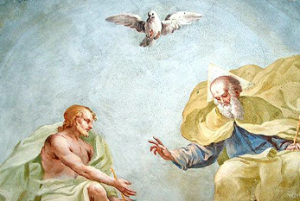What shape has the greatest sense of humour, a triangle, a square or a circle?
Asked, the famous artist and theorist, Wassily Kandinsky of his students in the Bauhaus Academy, Weimar, Germany.
The answer – almost unanimously – was a triangle.
Perhaps because triangles are pointy and have slopping sides, they seem far more ridiculous.
 Wassily Kandinsky, Black and Violet, 1922
Wassily Kandinsky, Black and Violet, 1922
But triangles have many other fascinating properties that go to the very heart of what a democracy is and what it isn’t!
Architects / designers Marion Mahony and Walter Burley Griffin knew the power of triangles. They designed the ceremonial heart of Canberra in the shape of the ‘national triangle’.
So what are some of the properties of triangles?
- Triangles are strong
- In fact triangles are the strongest shape of all
- As any added force or stress is evenly spread through all three sides
This is why you see triangles all over the place, in cranes, bridges, the roofs of our houses and in electricity pylons.


Stable democracies have rigid constitutions.
That’s a very special property for a new country and a new capital.
Triangles are imbued with many sexual and spiritual meanings
Female – pointy end down
Male = pointy end up
or spin for a ménage à trois
Occultists use the triangle as a summoning symbol.
At the culmination of a ritual, the desired being is expected to appear within a triangle inscribed upon the floor.


Triangles are connected to the life of the spirit, to the number three and to the idea of a trinity.
 Luca Rossetti da Orta, 1738-1739
Luca Rossetti da Orta, 1738-1739
To conjure the national triangle, in their award winning design the Griffins connected three summits Capital, Russell and City hill with three avenues, Commonwealth, Kings and Constitution Avenues.

 1913-preliminary-plan-of-Canberra
1913-preliminary-plan-of-Canberra
Triangles are musical
- The player makes a sound by hitting the triangle with a metal beater.
- The triangle rings out a shimmering harmonic of color vibrations
- A triangle can be beaten but it rarely breaks
- The triangle can always be heard clearly above the sound of the orchestra or band
or even the banter of politicians.
Unfortunately Triangles lost their sense of humor in World War Two
Two years after Walter Burley Griffin died in 1937.
The Nazis used triangles as badges to mark prisoners in concentration camps as ‘asocial’.
A double triangle was used for Jews, a black triangles for lesbians and a pink triangles for male homosexuals.


Triangles have regained some of their colour and vitality as the GLBTIQ community have reclaimed them as symbols of pride and solidarity.

Canberra has the highest population of LGBTIQ people, per population, in the nation.
The symbolism of black triangles has also been re-invented by disability groups in the U.K responding to criticisms that they are ‘workshy’.


‘Workshy’ – is a common criticism levelled at Canberra’s many Federal public servants.
But triangular relationships can be stressful and full of conflict
As three part symbols, triangles present concepts such as:
- Land, people, nation
- Judiciary, church and state
- Beginning, middle and end
In 1933, to escape the growing right wing hostility, Kandinsky left Germany for Paris.
He died in 1944. Today he is admired as the originator of abstract art.
 Wassily Kandinsky, Last Watercolour, 1944
Wassily Kandinsky, Last Watercolour, 1944
Like the Griffins, he believed that music, signs, line, and color ought to correspond to nature and to the vibrations of the human soul.
That brings my story about the heart of democracy, full circle





Leave a Comment